zabbix service and client deployment
2015-11-18 18:15
405 查看
what is zabbix?
英語實在太爛,沒辦法繼續了,但總有一天要將其變爲第一語言
先來看看官方給出的定義,纯官方摘过来的https://www.zabbix.com/documentation/2.2/manual/introduction/about
Zabbix is an enterprise-class open source distributed monitoring solution.
Zabbix is software that monitors numerous parameters of a network and
the health and integrity of servers. Zabbix uses a flexible notification
mechanism that allows users to configure e-mail based alerts for
virtually any event. This allows a fast reaction to server problems.
Zabbix offers excellent reporting and data visualisation features based
on the stored data. This makes Zabbix ideal for capacity planning.
Zabbix supports both polling and trapping. All Zabbix reports and
statistics, as well as configuration parameters, are accessed through a
web-based frontend. A web-based frontend ensures that the status of your
network and the health of your servers can be assessed from any
location. Properly configured, Zabbix can play an important role in
monitoring IT infrastructure. This is equally true for small
organisations with a few servers and for large companies with a
multitude of servers.
Zabbix is free of cost. Zabbix is written and distributed under theGPLGeneral Public License version 2. It means that its source code is freely distributed and available for the general public.
Commercial support is available and provided by Zabbix Company.
Learn more about Zabbix features.
约定:
系统:centos 6
软件版本:zabbix 2.2
安装目录:/usr/local/zabbix
说明:
软件需求:web(apache、nginx)、php、mysql,具体不在此做说明
此文档采用源码编译安装
还为做深入研究,这里只记录Server端和Clinet端的安装
正文:
下载软件:http://www.zabbix.com/download.php
一.服务端
1.创建用户
PostgreSQL (we assume that user username exists and has permissions to create database objects):
Oracle (we assume that user zabbix with password password exists and has permissions to create database objects in service ORCL):
If you are creating database for Zabbix server you need to have images somewhere on Oracle host:
Now prepare the database:
3.配置帮助信息
编辑/usr/local/zabbix/etc/zabbix_server.conf配置以下参数
经过上面配置,就可以通过$/usr/local/zabbix/sbin/zabbix_server启动服务,但这种启动方式并没有将zabbix服务加入系统服务,那就来配置吧。
服务脚本统一在源码目录misc/init.d下,这里又按系统做了区分,centos、redhat同属fedora,所以这里就要fedora的脚本做修改
vim /etc/init.d/zabbix_server
二.服务端web配置
拷贝文件到web目录site下http://httpd.apache.org/docs/2.2/vhosts/
1.浏览器打开http://localhost/zabbix
如果前面的配置正确,会看到安装向导
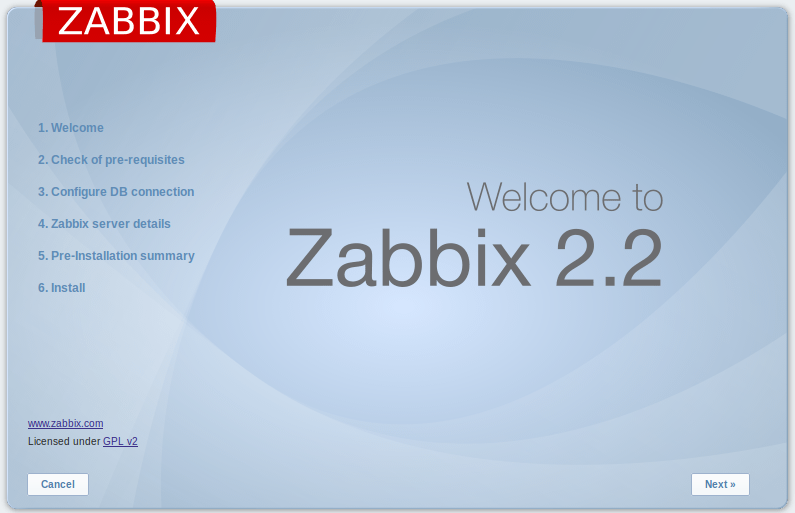
2.确认先决条件是否满足
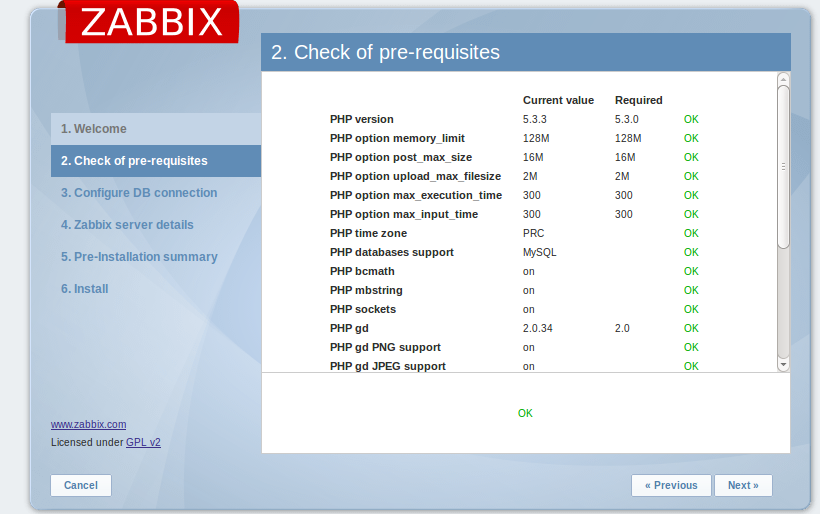
3.配置链接数据库信息,前提zabbix数据库必须已创建
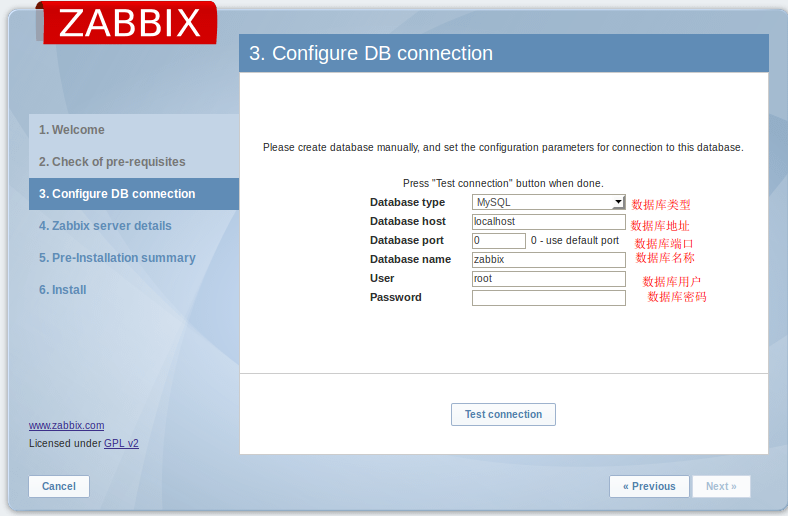
4.主机信息配置
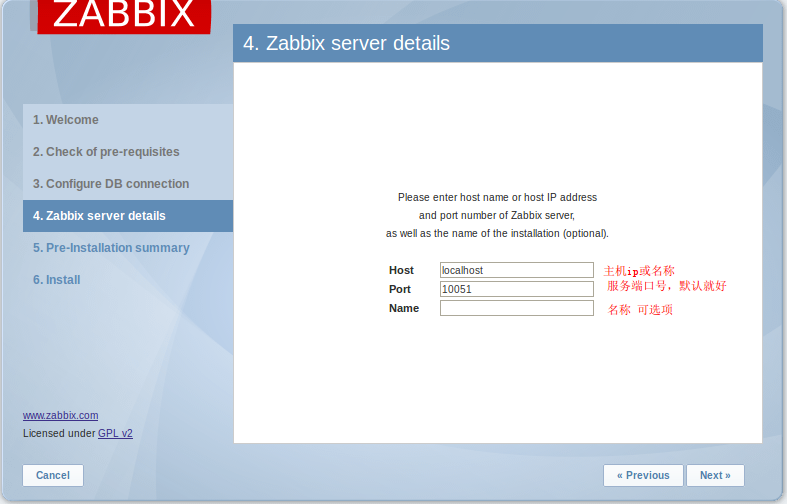
5.检查配置信息是否正确
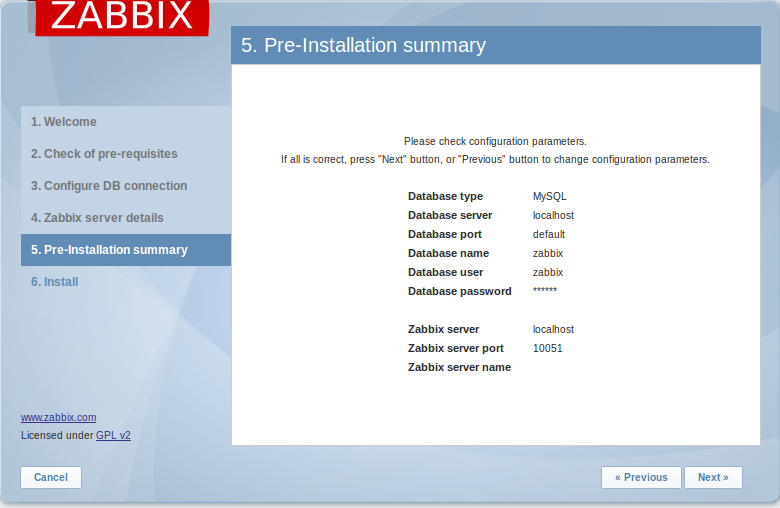
6.生成配置文件,这里可能会出权限问题,可将配置文件下载后上传到服务器,或修改目录权限
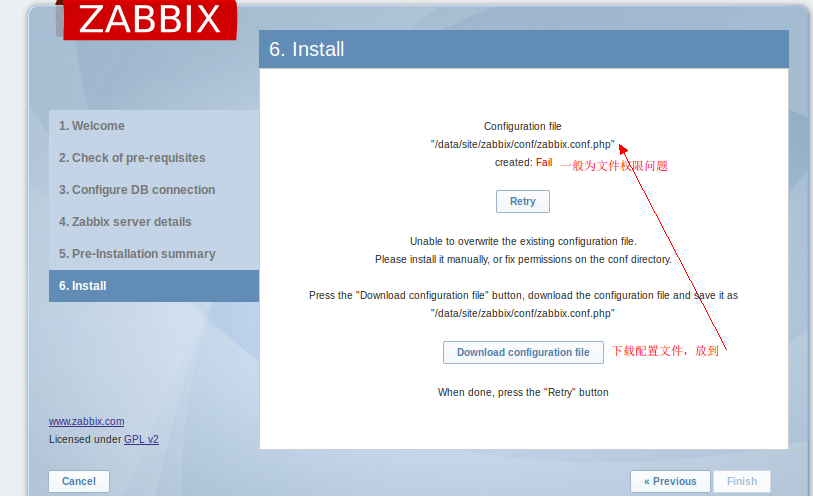
7.登录
默认用户为admin,密码为zabbix
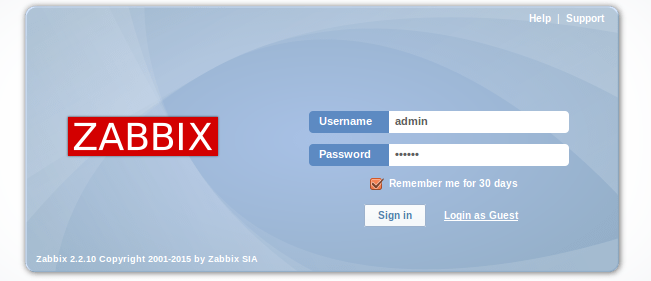
8.中文支持及字体更改
zabbix本身已集成中文,但需要手动开启后才会出现在语言设置中
编辑/site/zabbix/include/locales.inc.php文件,找到zh_CN,将后面的falsh改为true,就可在页面的语言设置中找到中文选项了
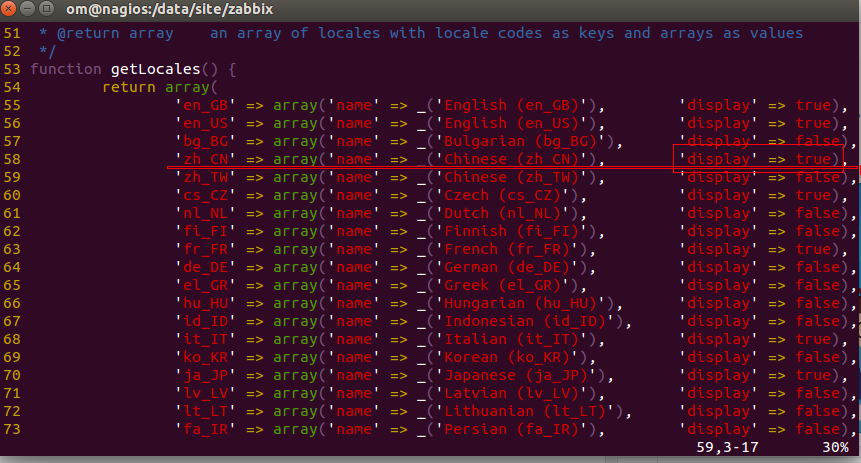
支持中文后,在图表数据中可能会出现乱码情况,与字体库有关,将windows下的C:\Windows\Fonts\simkai.ttf(楷体)上传到服务器 zabbix 网站目录 fonts 目录下
修改web目录/site/zabbix/include/defines.inc.php文件,做如下变更
三.客户端
1.客户端安装
编辑/usr/local/zabbix/etc/zabbix_agentd.conf配置以下参数
vim /etc/init.d/zabbix_agentd
service zabbix_agentd start
如何创建监控主机,待研究明白了在来补
英語實在太爛,沒辦法繼續了,但總有一天要將其變爲第一語言
先來看看官方給出的定義,纯官方摘过来的https://www.zabbix.com/documentation/2.2/manual/introduction/about
What is Zabbix
Overview
Zabbix was created by Alexei Vladishev, and currently is actively developed and supported by Zabbix SIA.Zabbix is an enterprise-class open source distributed monitoring solution.
Zabbix is software that monitors numerous parameters of a network and
the health and integrity of servers. Zabbix uses a flexible notification
mechanism that allows users to configure e-mail based alerts for
virtually any event. This allows a fast reaction to server problems.
Zabbix offers excellent reporting and data visualisation features based
on the stored data. This makes Zabbix ideal for capacity planning.
Zabbix supports both polling and trapping. All Zabbix reports and
statistics, as well as configuration parameters, are accessed through a
web-based frontend. A web-based frontend ensures that the status of your
network and the health of your servers can be assessed from any
location. Properly configured, Zabbix can play an important role in
monitoring IT infrastructure. This is equally true for small
organisations with a few servers and for large companies with a
multitude of servers.
Zabbix is free of cost. Zabbix is written and distributed under theGPLGeneral Public License version 2. It means that its source code is freely distributed and available for the general public.
Commercial support is available and provided by Zabbix Company.
Learn more about Zabbix features.
Users of Zabbix
Many organisations of different size around the world rely on Zabbix as a primary monitoring platform.约定:
系统:centos 6
软件版本:zabbix 2.2
安装目录:/usr/local/zabbix
说明:
软件需求:web(apache、nginx)、php、mysql,具体不在此做说明
此文档采用源码编译安装
还为做深入研究,这里只记录Server端和Clinet端的安装
正文:
下载软件:http://www.zabbix.com/download.php
一.服务端
1.创建用户
# groupadd zabbix # useradd -g zabbix zabbix2.创建数据库https://www.zabbix.com/documentation/2.2/manual/appendix/install/db_scripts
# cd /usr/local/src # tar -xzvf zabbix-2.2.2.tar.gz # cd zabbix-2.2.2MySQL (we assume that user username with password password exists and has permissions to create database objects):
shell> mysql -u<username> -p<password> mysql> create database zabbix character set utf8 collate utf8_bin; mysql> quit; shell> mysql -u<username> -p<password> zabbix < database/mysql/schema.sql # stop here if you are creating database for Zabbix proxy shell> mysql -u<username> -p<password> zabbix < database/mysql/images.sql shell> mysql -u<username> -p<password> zabbix < database/mysql/data.sql
PostgreSQL (we assume that user username exists and has permissions to create database objects):
shell> psql -U <username> psql> create database zabbix; psql> \q shell> cd database/postgresql shell> psql -U <username> zabbix < schema.sql # stop here if you are creating database for Zabbix proxy shell> psql -U <username> zabbix < images.sql shell> psql -U <username> zabbix < data.sql
Oracle (we assume that user zabbix with password password exists and has permissions to create database objects in service ORCL):
If you are creating database for Zabbix server you need to have images somewhere on Oracle host:
# copy directory create/images/old_images somewhere on Oracle server (e.g. /home/oracle): shell> scp -r create/images/old_images user@host:/home/oracle # edit file database/oracle/images.sql and set images_dir variable to where you have copied them (e. g. "/home/oracle/old_images"): CREATE OR REPLACE DIRECTORY image_dir AS '/home/oracle/old_images'
Now prepare the database:
shell> sqlplus zabbix/password@host/ORCL sqlplus> @database/oracle/schema.sql # stop here if you are creating database for Zabbix proxy sqlplus> @database/oracle/images.sql sqlplus> @database/oracle/data.sql
3.配置帮助信息
#./configure --help4.服务端安装-mysql db
# ./configure --prefix=/usr/local/zabbix/ --enable-server \ --enable-agent --with-mysql --with-net-snmp --with-libcurl --with-libxml2 # make && make install5.服务端安装-PostgreSQL
#./configure --enable-server --with-postgresql --with-net-snmp6.服务端配置
编辑/usr/local/zabbix/etc/zabbix_server.conf配置以下参数
LogFile=/tmp/zabbix_server.log #日志文件 DBName=zabbix #数据库名称 DBUser=zabbix #数据库用户名 DBPassword=zabbix #数据库密码 DBPort=3306 #数据库端口7.系统服务配置
经过上面配置,就可以通过$/usr/local/zabbix/sbin/zabbix_server启动服务,但这种启动方式并没有将zabbix服务加入系统服务,那就来配置吧。
服务脚本统一在源码目录misc/init.d下,这里又按系统做了区分,centos、redhat同属fedora,所以这里就要fedora的脚本做修改
cp misc/init.d/fedora/core/zabbix_server /etc/init.d/zabbix_server编辑/etc/init.d/zabbix_server,修改以下参数
vim /etc/init.d/zabbix_server
BASEDIR=/usr/local/zabbix/ #zabbix安装目录加入系统服务
chkconfig --add zabbix_agentd chkconfig --level 345 zabbix_agentd on启动zabbix服务
$service zabbix_server start这里还有个问题,就是SElinux的安全验证,可使用setenfroce 0暂时关闭selinux临时解决下
二.服务端web配置
拷贝文件到web目录site下http://httpd.apache.org/docs/2.2/vhosts/
cp -rp /usr/local/zabbix-2.2.2/frontends/php /site/zabbix/apache配置
<Directory "/site/zabbix"> Options FollowSymLinks AllowOverride None Order deny,allow Allow from all </Directory> <VirtualHost *:80> #ServerAdmin DocumentRoot /site/zabbix ServerName localhost ErrorLog logs/dummy-zabbix.com-error_log CustomLog logs/dummy-zabbix.com-access_log common </VirtualHost>nginx配置
server {
listen 80;
server_name localhost;
access_log zabbix.com.access.log main;
index index.html index.php index.html;
root /site/zabbix;
location /
{
try_files $uri $uri/ /index.php?$args;
}
location ~ ^(.+.php)(.*)$ {
fastcgi_split_path_info ^(.+.php)(.*)$;
include fastcgi.conf;
fastcgi_pass 127.0.0.1:9000;
fastcgi_index index.php;
fastcgi_param PATH_INFO
$fastcgi_path_info;
}
}安装前端1.浏览器打开http://localhost/zabbix
如果前面的配置正确,会看到安装向导

2.确认先决条件是否满足

| Pre-requisite | Minimum value | Description |
|---|---|---|
| PHP version | 5.3.0 | |
| PHP memory_limit option | 128MB | In php.ini: memory_limit = 128M |
| PHP post_max_size option | 16MB | In php.ini: post_max_size = 16M |
| PHP upload_max_filesize option | 2MB | In php.ini: upload_max_filesize = 2M |
| PHP max_execution_time option | 300 seconds | In php.ini: max_execution_time = 300 |
| PHP max_input_time option | 300 seconds | In php.ini: max_input_time = 300 |
| PHP session.auto_start option | must be disabled | In php.ini: session.auto_start = 0. |
| Database support | One of: IBM DB2, MySQL, Oracle, PostgreSQL, SQLite | One of the following modules must be installed: ibm_db2, mysql, oci8, pgsql, sqlite3 |
| bcmath | php-bcmath | |
| mbstring | php-mbstring | |
| sockets | php-net-socket. Required for user script support. | |
| gd | 2.0 or higher | php-gd. PHP GD extension must support PNG images (--with-png-dir), JPEG (--with-jpeg-dir) images and FreeType 2 (--with-freetype-dir). |
| libxml | 2.6.15 | php-xml or php5-dom |
| xmlwriter | php-xmlwriter | |
| xmlreader | php-xmlreader | |
| ctype | php-ctype | |
| session | php-session | |
| gettext | php-gettext Starting with Zabbix 2.2.1, the PHP gettext extension is no longer a mandatory requirement for installing Zabbix. If gettext is not installed, the frontend will work as usual, however, the translations will not be available. |

4.主机信息配置

5.检查配置信息是否正确

6.生成配置文件,这里可能会出权限问题,可将配置文件下载后上传到服务器,或修改目录权限

7.登录
默认用户为admin,密码为zabbix

8.中文支持及字体更改
zabbix本身已集成中文,但需要手动开启后才会出现在语言设置中
编辑/site/zabbix/include/locales.inc.php文件,找到zh_CN,将后面的falsh改为true,就可在页面的语言设置中找到中文选项了

支持中文后,在图表数据中可能会出现乱码情况,与字体库有关,将windows下的C:\Windows\Fonts\simkai.ttf(楷体)上传到服务器 zabbix 网站目录 fonts 目录下
修改web目录/site/zabbix/include/defines.inc.php文件,做如下变更
sed -i 's/DejaVuSans/simkai/g' ./include/defines.inc.php
43行
define('ZBX_GRAPH_FONT_NAME', 'DejaVuSans'); // font file name 修改前
define('ZBX_GRAPH_FONT_NAME', 'simkai'); // font file name 修改后
90行
define('ZBX_FONT_NAME', 'DejaVuSans'); 修改前
define('ZBX_FONT_NAME', 'simkai'); 修改后三.客户端
1.客户端安装
# groupadd zabbix # useradd -g zabbix zabbix
#./configure --enable-agent --prefix=/usr/local/zabbix/ make && make install2.客户端配置
编辑/usr/local/zabbix/etc/zabbix_agentd.conf配置以下参数
LogFile=/tmp/zabbix_agentd.log #日志配置 Server=127.0.0.1 #zabbix服务端地址,允许服务端主动来取数据 ServerActive=127.0.0.1 #zabbix服务端地址,主动向服务端提交数据 Hostname=Zabbix server #客户端名称,这个名称后面在服务端添加监控主机时要用到3.加入系统自启动服务
cp misc/init.d/fedora/core/zabbix_server /etc/init.d/zabbix_agentd编辑/etc/init.d/zabbix_agentd,修改以下参数
vim /etc/init.d/zabbix_agentd
BASEDIR=/usr/local/zabbix/ #zabbix安装目录加入系统服务
chkconfig --add zabbix_agentd chkconfig --level 345 zabbix_agentd on启动客户端
service zabbix_agentd start
如何创建监控主机,待研究明白了在来补
相关文章推荐
- Python 实现Zabbix自动发送报表
- Zabbix安装详解
- Zabbix监控Linux主机设置方法
- Zabbix监控交换机设置方法
- 集群运维自动化工具ansible之使用playbook安装zabbix客户端
- zabbix进行数据库备份以及表分区的方法
- 部署企业级zabbix+Orabbix监控Oracle数据库
- zabbix 触发器 Triggers
- zabbix 分布式部署
- zabbix event事件
- zabbix配置指南
- zabbix 监控windows 服务器
- zabbix服务器安装教程
- zabbix之固定端口监控redis ,zabbix监控memcached
- zabbix监控进程的CPU和内存占用量,进程数量
- Zabbix日志监控:Linux异常登录告警
- zabbix应用之nginx统一监控
- Zabbix 常用Key值
- zabbix 监控服务系列之--------NO1源码包安装篇
- Zabbix添加自定义监控项
